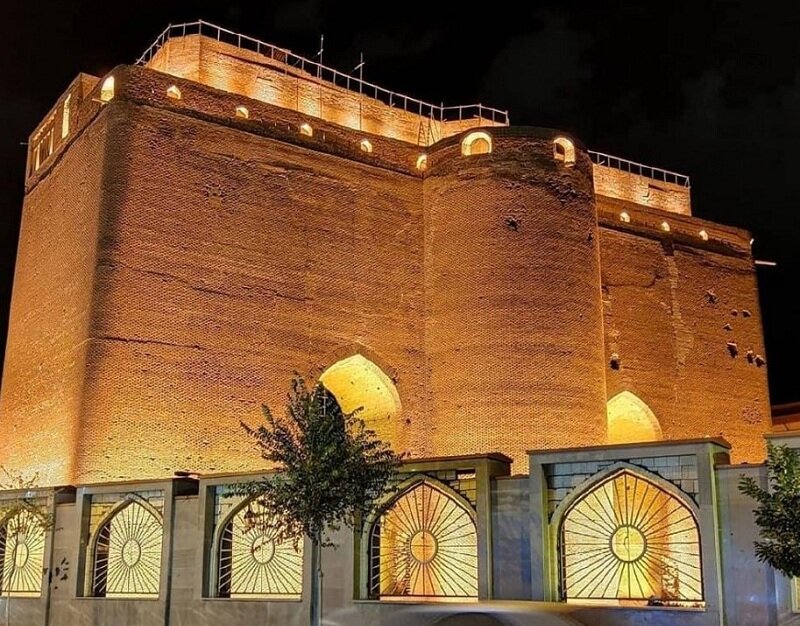Arg of Tabriz: a testament to Ilkhanate splendor

TEHRAN – For centuries, the Arg of Tabriz, although partially in ruins today, has captivated visitors with its historical significance and architectural splendor.
Originally constructed in the 14th century during the Ilkhanate era, the monument also is known as Arg-e Ali Shah, the Arch of Ali Shah, and the Mosque of Ali Shah. As a magnificent compound, it originally featured a grand vaulted mosque, adjoining prayer halls, extensive libraries, a vast courtyard with a huge reflecting pool, and a mausoleum, all encompassed by massive walls.
The Ilkhanid dynasty, also called Il-Khanid, was a Mongol dynasty that ruled Iran from 1256 to 1335. Il-Khan is Persian for “subordinate khan”.
According to Archnet, the monument was believed to be the largest brick structure ever built, was the brainchild of Ali Shah, the Iranian vizier during the reign of Oljeitu and Abu Sa’id. “The scale and grandeur of this complex reflect the architectural ambitions of the Ilkhanid period, underlining the importance of Tabriz as a cultural and political center at the time.”
Whether you are a history enthusiast, an architecture aficionado, or even a curious traveler, the Arg of Tabriz promises a rich and rewarding experience.Ali Shah was the patron and possibly the designer of the mosque’s plan. The structure was organized around a traditional courtyard mosque layout with four iwans. However, it featured a unique design where the mihrab was housed in a majestic iwan, negating the need for an additional domed structure. Some experts say its innovative approach highlights the blend of traditional Islamic architecture with the distinctive style of the Ilkhanate period.
The mosque’s rectangular courtyard, paved with marble, measured an impressive 286 meters wide by 229 meters long. Entered through a pishtaq—a rectangular frame around an arched opening—the courtyard featured iwans on the west and east sides and a large iwan on the southernmost wall, oriented towards the qibla. The mihrab, positioned at the center of the qibla wall, is adorned with three relieving arches, adding to the structure’s architectural elegance. High above the ground level, two windows flank the mihrab, contributing to the airy and light-filled ambiance of the mosque.
At the center of the courtyard was a square pool with an octagonal fountain, featuring jets and four lions spouting water from their mouths. This intricate water feature, combined with the alabaster columns of the stone-vaulted arcade surrounding the courtyard, created a serene and visually stunning environment. Trees were strategically planted at each of the four corners of the courtyard, enhancing the tranquility and beauty of the space.
The massive brick walls of the Arg, plain yet imposing, are characteristic of Mongol architecture in Persia. These walls, along with the curved corners of the qibla wall and the rounded bastion behind the mihrab recess, are some of the few remaining elements of the original structure. The iwan vault, which once spanned 30 meters in width and 48 meters in depth, tragically collapsed shortly after construction. Despite this, the remnants of the Arg still convey the grandeur of its original design.
Adjacent to the iwan walls were a madrasa and a khanqa, which likely provided the financial support necessary to sustain the mosque. Although little is known about these structures due to their complete collapse, their existence points to Arg’s role as a center of learning and religious devotion.
In later centuries, the Arg was repurposed as a citadel, leveraging its massive walls for defense. This transformation earned it the local name “Arg” or fortress. During the 19th century, amidst rising tensions between Iran and Russia, the Arg was further fortified with additional military installations, including barracks and a cannon foundry. These additions underscore the strategic importance of the Arg in Tabriz’s military history.
In the 20th century, the military installations were removed, and the surrounding area was transformed into a park, enhancing the Arg’s appeal as a public space. A significant mosque was also constructed adjacent to the citadel, further cementing the Arg’s role as a focal point of religious and cultural activity in Tabriz.
Today, the Arg of Tabriz is a destination for tourists, offering a unique glimpse into the historical and architectural legacy of the region. Visitors can marvel at the remnants of this once-grand structure, explore the surrounding park, and reflect on the Arg’s storied past. Whether you are a history enthusiast, an architecture aficionado, or even a curious traveler, the Arg of Tabriz promises a rich and rewarding experience.
AM
Leave a Comment